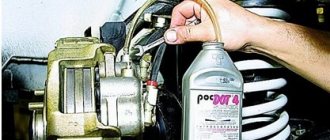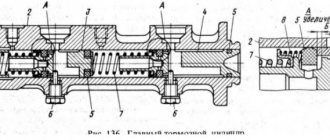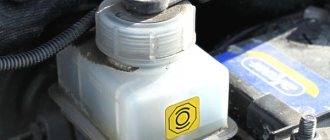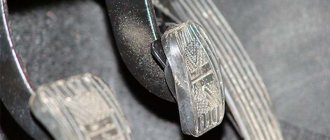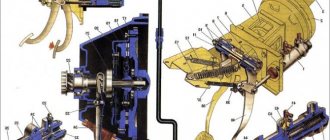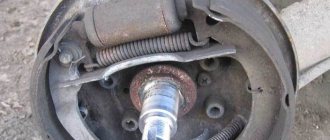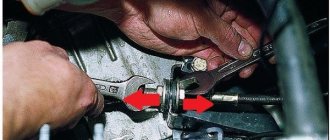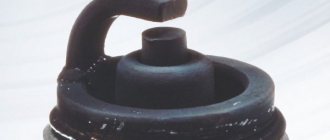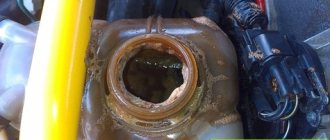After independently repairing the brake system, the car enthusiast is faced with the question: how to bleed the brakes himself. Bleeding the brake system means removing air from it. This must be done in order to bring it into working condition. Since, due to the entry of a large volume of air into it, the efficiency of its action is reduced so significantly that when braking, the pedal falls through, and the car does not even slow down. The brakes of modern cars, with the exception of parking ones, are hydraulic. Therefore, it is necessary to pump both disc and drum ones. They are pumped in the same way; disc ones are aired in the same way as drum ones.
When to bleed the brake system
- After replacing the fluid.
- After replacing the brake hoses.
- When increasing the brake pedal travel.
- When, when you press it, the pedal becomes soft or fails, that is, when the system becomes airy. Before pumping, be sure to find which unit is broken and eliminate the cause of air getting inside.
- If you have replaced the master or slave cylinder.
There is no need to bleed the system after replacing the pads. It is enough to press the pedal several times for the pads to take their places.
After replacing the pads, braking performance will be slightly lower than before. It will recover on its own after grinding in the pads while driving. Disc brakes are no different from drum brakes. Let's look at how to properly bleed the brakes.
If there is no assistant
There are many ways to bleed the brakes alone, but the results are not as good as the results of traditional bleeding with an assistant. Therefore, I advise you to use them only when there is not a soul around and no one to ask to press the pedal several times. This difference is explained by the fact that when pumping without an assistant, during the reverse stroke of the master cylinder piston, there is no one to close the fitting, so the system remains leaky. When the master cylinder creates a vacuum in the system, air will inevitably enter there. Because of this, when braking after pumping without an assistant, you will feel some softness.
Several methods for those who decide to bleed the system on their own without an assistant:
If your car has a brake fluid level sensor in the cover, you will have to buy another cover to make such a device.
- Some of the air will leave the system if, after adding fluid, you simply leave the fitting open for several tens of seconds.
- Using a gas stop on the hood or trunk lid. Press the pedal several times. If it falls through, pull it back. Place the compressed gas stop so that it presses the pedal, pushing away from the driver's seat. Unscrew the bleeder fitting. As liquid and air exit through the fitting, the pressure in the system will decrease. Therefore, the gas stop, unclenching, will press the pedal to the floor. When the fluid stops flowing, you need to tighten the fitting, press the pedal again several times and set the stop.
- Drill the brake reservoir cap. Insert the valve from the tubeless wheel into the hole. Make sure there is liquid in the reservoir. Use a pump to create a slight excess pressure in the tank. Unscrew the bleeder fitting on the working cylinder and let the fluid and air drain out. Don't forget to add fluid to the reservoir. As soon as the fluid flows without air, tighten the fitting and move to the other wheel.
Vostok Auto
A car's brakes are an important part of ensuring its proper and safe operation.
Any breakdown of the brake system can lead to problems or even tragedy. To avoid problems when driving, it is necessary to constantly monitor the condition of each element of the brakes, especially the brake fluid. Bleeding the brakes is possible in different ways. It is possible to contact a car service. In this case, the car's brakes are pumped using a special device. It is an effective technical device that helps remove air masses from the car brake system. This professional unit, which is used to bleed the brake system, is equipped with adapters for different car models.
Another method is to bleed the brakes yourself. In general, the procedure for bleeding the brakes is the same for any system. You will need to make a simple device for bleeding the brakes with your own hands, the elements of which are a syringe, tubes, and a plastic container. Bleeding ABS brakes can be done alone or by two people.
The brake bleeding scheme assumes that the process begins from the wheel located further from the turbocharger.
How to remove air from the brake system
When repairing the brake system, the procedure for bleeding car brakes was followed. There is air left in the system. Typically, a sufficient number of rocking cycles have not been performed. And the air was not completely removed. Or the frequency of pumping the wheels has been disrupted. It is necessary to bleed the cylinders from the furthest one relative to the main brake cylinder. Each cylinder is pumped sequentially, gradually approaching the GTZ.
Perhaps the repair was not carried out efficiently and there is a brake fluid leak. At the point of leakage, air enters the system. The bleeder fitting is not tightened; the cuffs are damaged during assembly. One way or another, the system must be checked for leaks. There should be no brake fluid leakage. If everything is normal, then the system needs to be pumped again.
Procedure for bleeding the brakes
You can pump the brakes yourself, or you can have an assistant, whose task is to press the brake pedal on command. The procedure for bleeding the brakes should be found in the manual for a specific car.
If the diagram is not indicated, then bleeding is done in the form of the letter Z. This means that you need to pump in this order : right rear - left rear - right front - left front wheel.
To bleed the brakes, you will need a brake fluid container and a clear rubber hose.
The necessary set of tools for work
When you notice the first symptoms of a problem with the brakes, you need to decide whether it is possible to contact a service center. Our specialists have the necessary experience and skills to carry out work quickly and safely. Equipment plays a special role in solving the problem.
We recommend: Spare parts for Volvo VNL trucks
If in specialized places they use unique devices with universal adapters for any car, then when bleeding the brakes with your own hands, improvised means are sufficient. To carry out this, you need to acquire a set of appropriate keys, a container for brake fluid and several hoses. The diameter of the holes must completely match the bleeder fittings.
What is the essence of sequential pumping
It is necessary to pump hydraulic brakes in a certain sequence to make this process faster and easier. If you don't follow the optimal sequence, they will also level up, but it will take longer.
Having understood the principle by which the pumping sequence is determined, you don’t have to remember the diagrams. The idea is to start bleeding from the wheel closest to the driver's seat. This is explained by the fact that the shorter the path connecting the master brake cylinder to the working one, the easier it is to remove air from it. And it will no longer interfere with airing long brake pipes.
Bleeding the brakes of a left-hand drive car begins with the left front wheel. Behind it, the brake cylinder of the right front wheel is pumped. Then they switch to the rear ones, first the working cylinder of the left wheel, then the right one.
On a right-hand drive car, they begin to bleed the brake cylinder of the right front wheel first, then move to the left side. And then you can grab the rear part, first the cylinder of the right wheel, then the left.
The reverse sequence option (we pump the system in order, starting with the most distant area) is also used.
Useful tips
A wrench that will help unscrew stuck brake pipes
When bleeding hydraulic brakes, make sure there is fluid in the reservoir. Because if the main brake catches air, everything will have to start all over again.
- When bleeding the rear wheel working cylinder, do not jack up the car. The rear part must be on wheels, otherwise the pressure regulator, blocking the line, will not allow you to complete the repair.
- If the fitting is broken, do not drill it out; this will damage the slave cylinder. Try to turn it out this way: wet it with a wedge, while it is soaking, sharpen an old good steel screwdriver on sandpaper like a tetrahedral awl. Carefully hammer the sharpening point into the fitting and try to unscrew it.
- To unscrew the bleeder fitting, use only a spanner or socket. Because it is easy to damage the edges with an open-end wrench.
- When pumping disc brakes, also evaluate the wear of the discs and pads. The thickness of new pads (excluding metal thickness) is usually about 8 mm. Disc wear can be assessed by the difference in thickness between the outer edge and the middle part. A disc thickness of less than 11 mm is a real danger. The thickness of a new disk is usually about 15 mm.
Most often, the pedal fails when the brake hose breaks. If it fails while driving, don’t waste time, grab the handbrake.
Reasons for air getting into the brake circuit of a car
One of the things that causes brakes to fail is if air gets into the system itself. Air can get in due to a leak, poor maintenance, or insufficient brake fluid.
If air gets into your brake system, it can cause the brake pedal to become softer or easier to press. It can also increase braking distance. This happens because the air is actually compressed inside the brake system when you press the brake pedal, rather than the piston in your caliper. This reduces the car's braking force and can cause a dangerous situation.
Why does the brake system need to be bled?
The term "brake bleeding" refers to the process in which a small valve on the caliper (or wheel cylinder) is opened to allow controlled amounts of brake fluid to leave the system.
We bleed the brakes to release air that sometimes gets trapped inside the lines. Technically, "air" only enters the lines if there is a threat to sealing the system (for example, when flex lines are removed or replaced), because when the liquid boils, it creates "steam" instead. Vapor in brake fluid, such as air, will create a loss of efficiency in the braking system. However, for simplicity, we use the term "air" in this article to describe both air and liquid vapor.
When air (or vapor) is present in the lines, it creates inefficiency in the system because, unlike liquid, air can be compressed. So when enough air fills the lines, the supply to the pedal simply causes the air to compress rather than create pressure on the brakes. In other words, when air is present in the system, the effectiveness of the braking system is reduced. Typically, a small amount of air in the brake system will result in a soft pedal (because it takes less energy to compress the air than it does to move fluid through the brake lines.) If enough air enters the brake system, it can cause the brakes to fail completely.
How does air get into the lines? Sometimes this may be the result of a maintenance or upgrade procedure, such as replacing flex lines with standard stainless steel braids. But this is often the result of high temperatures that cause brake fluid components to boil, releasing gases from the boiling fluid into the brake hydraulic system.
ADVICE! Under normal operating conditions and without modifications to the brake system, typical original brake systems were designed to NOT require bleeding during the life of the vehicle unless the system is opened for repair or replacement. If you're just driving around town or on the highway to work, there's no need to pump your brakes! However, there are a few European manufacturers that recommend replacement on a semi-regular basis for other reasons, so be sure to check your manual or talk to your mechanic.
Those who choose autocross or sport driving can renew their brake fluid and perform an annual bleed - this is a good "early season" service item for low-speed driving enthusiasts.
Car brake system diagram
Brake fluid selection
In theory, even plain water will do - since, being a liquid, water cannot be compressed. However, it is important to remember that the main function of the braking system is to convert kinetic energy into thermal energy through friction. And the reality of this process is that some parts of the brake system will be exposed to very high temperatures. In fact, it is not uncommon for the rotor temperature to reach 600ºC while the vehicle is in motion, which can raise the temperature of the brake fluid to 150ºC. Since the boiling point of water is 100ºC, it is obvious that the water in the brake system can easily boil - and therefore release gases into the brake pipes - reducing the effectiveness of the system.
ATTENTION! Water is also a big problem in cold weather if it freezes to ice!
The "obvious" solution to this problem is to use a fluid that is less sensitive to extreme temperatures. Hence the development of “brake fluid”. However, unfortunately, there is no “ideal” brake fluid. And like most things in the world, adding certain useful features usually comes with trade-offs in other areas. With brake fluid, we typically must balance the fluid's sensitivity to temperature, its cost, and its effect on other components in the system.
Simply put, you can reduce the sensitivity of a liquid to temperature by varying its ingredients. However, certain combinations of ingredients can significantly increase the cost of the fluid and can react with original materials, damaging seals and causing corrosion of the entire brake system.
How to bleed brakes
To bleed the brakes according to the standard procedure, two people are needed. To do this, you need to pour brake fluid into the master cylinder reservoir, after which one person sits behind the wheel and presses the brake pedal from time to time. An assistant, having cleared dirt from the brake cylinder fittings before bleeding, unscrews the fitting. The first one at this time begins to smoothly press the brake. As soon as bubbles stop coming out of the fitting along with the brake fluid, and a clean stream comes out, the brake cylinder fitting is tightened.
Practical tips and nuances when bleeding brakes
Even if you follow all the points of the detailed instructions, you cannot be completely sure of the correctness of your actions and a reliable result. Experienced motorists know that the secrets of any independent manipulations in the car lie in the details.
While working with each wheel, it is worth tilting the car slightly in the appropriate direction. In this case, the air inside the system will rise up and flow faster to the threaded valve. Additionally, the process is activated by a slight vibration if you tap on the caliper.
In addition to the main method, you can bleed the brakes by gravity. It is necessary to unscrew the valves and add the necessary brake fluid to the supply tank in time. The procedure is quite lengthy and is only available to experienced car enthusiasts. Moreover, it is not suitable for vehicles equipped with return pressure control valves.
Bleeding the brakes, relying solely on your own experience, is fraught with breakdowns in the brake system. Incorrect actions can lead to large accumulations of air in the lines. Before you start working, you should familiarize yourself with the experiences of other people or watch training videos on the Internet:
Sources
- https://luxvaz.ru/vaz-2114/199-zamena-tormoznoy-zhidkosti.html
- https://DriverTip.ru/repair/kak-pravilno-prokachat-tormoza.html
- https://remontvazov.com/tormoznaja-sistema-vaz-2114
- https://pricurivatel.ru/prokachka-tormoznoj-sistemy.html
- https://vvm-auto.ru/publikatsii/674-kak-pravilno-prokachat-tormoznuyu-sistemu
- https://fastmb.ru/autoremont/20-prokachka-tormoznoy-sistemy-poshagovaya-instrukciya.html
- https://NaDomkrat.ru/ustroistvo-avtomobiley/tormoznaya-sistema/tormoznaya-sistema-vaz-2114
Bleeding the brakes with an assistant
This method does not require additional devices; all actions are performed in the car with the ignition turned off. The assistant's task is to create pressure in the brake system.
If a person is doing this for the first time, explain to him how important coordination of actions is; he makes movements only at your command. Under no circumstances should you release the pedal before you tighten the fitting. If this happens, the system will suck in air and you will have to start the bleeding procedure all over again.
- Unscrew the cap of the expansion tank and fill it to the maximum possible level.
- Take a place at the right rear wheel, put a tube on the fitting, and immerse the other end in a container. It is important that the other end is in the liquid. Then, even if the assistant releases the pedal ahead of time, it will be drawn into the system, not air.
- On command, the assistant pumps the brake pedal until it becomes hard and loses its range.
- Without releasing pressure on the pedal, the assistant reports readiness.
- You slowly unscrew the fitting and watch how the “brake fluid” comes out along with air bubbles.
- When the pedal goes to the floor at about 3/4 of its travel, the assistant immediately reports this so that you tighten the fitting.
- As soon as this is done, the assistant begins to pump the pedal again. The number of iterations depends on the amount of air.
- If no air bubbles are observed after 3-5 iterations, move on to the next wheel. Don't forget to check the level in the tank.
How to properly and quickly bleed ABS brakes with your own hands
The procedure for bleeding the brakes is influenced by the design of the system, the location of components and the presence of additional electronic modules. The correct sequence is important. You need to start by relieving the pressure in the hydraulic accumulator. To do this, you need to turn off the ignition (it is not necessary to start the engine) and pump the pedal.
A simple secret to quickly pumping brakes. Video:
Read how to bleed ABS brakes and stock up on the following materials, parts, accessories and tools:
- spanner;
- a rubber (possibly plastic) hose with a diameter corresponding to the thickness of the fitting tip;
- brake fluid;
- container (necessarily transparent). This is where you will drain the old brake fluid.
You cannot do without an assistant who must press the pedal on command. You will perform manipulations with the fittings that ensure the removal of liquid.
Bleeding ABS brakes, where the components are located in one unit, differs little from the standard procedure. The only thing you need to do is turn off the system by pulling the fuse. This method works on domestic Ladas.
You can take advantage of the built-in pump. Then you will have to pump with the ignition on or even with the engine running. The sequence and order of bleeding the brakes starts with the right front cylinder and looks like this:
- disconnect the terminal of the level control sensor fixed on the expansion tank cover;
- remove the cover;
- open the brake reservoir;
- fill the reservoir to the brim with brake fluid;
- put the hose on the tip of the fitting;
- lower the end of the hose into a container to collect liquid;
- open the fitting by turning it a quarter or half a turn;
- to activate electronic systems, turn on the ignition;
- release the brake;
- wait until the pump expels the airy mixture;
- release the brake pedal;
- Tighten the fitting with a wrench.
The brake bleeding scheme is no different on any car, be it Patriot, Lacetti, Ford, Passat, Gazelle. First, air is removed from the “far” circuit (for “left-hand drive” cars it is on the right), then from the “near” circuit.
Important: When bleeding, keep an eye on the brake fluid level. If it falls below the minimum, the system will fill with air. Then the work has to be done again.
To bleed a system with components located in different places, a diagnostic tester is needed. It connects to the car and allows you to control electronic components using a smartphone or computer. In this case, you will also have to unscrew the fittings and drain the airy liquid. However, no manipulation of the pedal is required. Instead, the valves and electric pump must be activated using the appropriate menu items. This way you can bleed the systems on the VW Passat B6 and other modern cars.
Bleeding the brakes using the Priora as an example
Before you bleed the ABS brakes, you will have to drive the car into a pit. This will help you gain convenient access to the fittings on the rear cylinders and will allow you to avoid removing the discs during operation. On the Priora, the procedure for pumping brakes with ABS does not differ from that adopted on simpler models. The only difference is that the work must be performed by first turning on the ignition. In this case, the solenoid valves will be in the open position.
How to properly bleed the brakes on a Priora with abs with your own hands, video:
The work starts from the right rear and is done like this:
- disconnect the wires from the tank lid;
- unscrew the lid;
- Fill the reservoir with brake fluid to the brim;
- remove the protective cap;
- loosen the fitting using a spanner wrench;
- connect a tube to the tip of the fitting;
- lower the tube into the container;
- pump the brake pedal;
- press and hold it in this state (you need an assistant for this);
- open the fitting by turning it with a key;
- wait until the fluid flows out (the brake pedal goes down);
- tighten the fitting;
- pump up the pedal and release the “brake” until liquid that does not contain air bubbles comes out of the tube;
- tightly tighten the drain fitting;
- remove the tube with the spanner;
- put on the cap.
After this, it is necessary to repeat the work on the remaining three cylinders. To access the fittings on the front cylinders, you will have to jack up the car and remove the wheel rim.
Pumping the brakes using the example of “Grants” and “Kalina”
The technology for pumping brakes with ABS on the Kalina and Granta models is no different from that described in the section for Priora. Therefore, you can safely use it1, it is suitable for the entire model range of the VAZ brand.
Advice: after bleeding the brakes, do not rush to leave the garage immediately. It is necessary to check their system functionality. Make sure there are no pedal dips or leaks.
Procedure
Success and high-quality pumping of the brake system lies in following the entire technology of action:
- The first step is to replace the fluid in the GTZ tank or check its quantity and, if necessary, top it up to the maximum level.
- For more comfortable work, it is necessary to clean all air release valves on each wheel from dirt, dust and deposits.
- According to the correct sequence provided in the instructions, it is necessary to unscrew the fitting plug on the desired wheel and attach the prepared hose over the valve.
- The second end of the tube is placed in a previously prepared container with brake fluid.
- The partner progressively presses the brake pedal from 3 to 5 times and at the last movement fixes the pedal in the pressed position.
- At this time, you need to unscrew the air valve halfway. After opening the valve, liquid along with air bubbles will begin to flow through the tube into the container. When the pressure of the liquid escaping into the container disappears, the valve can be screwed back firmly, and your partner can release the brake pedal.
- The process may have to be repeated several times on each node. The main thing is to maintain the wheel sequence and control the amount of fluid in the master cylinder reservoir.
After pumping is completed, you need to make sure that the fitting plugs are tight and that the brakes are operating. After the test, if successful, the brake operation will return to normal. If the driver still feels problems in operation, then perhaps attempts to bleed the brakes with their own hands were unsuccessful, or there is a problem with the wear of the pads or discs.
How to properly bleed the brakes on a car without ABS?
Sequence and device for bleeding the brakes:
- Rear left wheel (RL)
- Salary
- PP
- PL
Before describing further actions, it is worth clarifying one more point so that no questions arise in the future. The thing is that on a car where the distribution of brake forces along the axes (sorcerer) is provided, it is necessary to switch the handle of the so-called sorcerer in order to simulate the situation of a fully loaded car. This will lead to maximum efficiency of the entire brake system line, which will simplify the entire bleeding process several times.
Sequence of actions for a car without ABS
- Unscrew the cap from the exhaust valve responsible for ventilation of the wheel brake cylinder. Then clean the valve and put a clean hose on it. Lower the reverse side of the tube into a container only half filled with brake fluid.
- Now your assistant needs to squeeze the brake shoe until it becomes obvious that pressure has built up in the brake line. The response of the pedal will help you understand whether it has formed there or not - the more resistance it gives, the better the pressure in the system.
- The pressure is increased by fully pressing and then holding down the brake pedal.
- Unscrew the air outlet valve half a turn. You will notice that liquid has begun to flow into the container. Make sure the back of the hose is immersed in the liquid.
- As soon as you notice that the pressure in the system has dropped, tighten the ventilation valve.
- Bleed the brake line again with the brake shoe depressed.
- Bleed the brakes again until all air bubbles in the hose have evaporated.
- After this, you can remove the hose from the outlet valve and screw on the protective cap, preferably a new one.
- Repeat all eight of these steps on the other wheels of the car.
Methods for pumping brakes yourself
The first thing you should do is prepare the new fluid that you will be pouring into the brakes.
Do not forget about the gas stop, which was already mentioned above, this can be the stops of the rear door or hood, and the container into which you will bleed the liquid.
Then you need to add brake fluid to the reservoir if required. After this, feel free to get into the cockpit and prepare the gas stop.
Press the brake pedal up to ten times quickly and sharply, then leave your foot in the locked pressed position.
After this, change your foot to the gas stop, lean it on the seat and make sure that it holds the pedal very tightly and rigidly, and there is no chance that it will come off.
After all these manipulations with the brake, go to the first selected wheel (usually the rear right) and begin to bleed the brake fluid and air from it.
To do this, you need to unscrew the fitting with a small key (pick it up in advance).
While you are bleeding air and fluid, a gas stop in the cabin presses the brake pedal tightly to the floor.
Types and types of ABS anti-lock systems
Based on the number of control circuits, there are three types of anti-lock braking systems:
- single-channel - when one wheel is blocked, all four are released;
- two-channel - triggering occurs based on data from the best (high-threshold) or worst (low-threshold) wheel;
- four-channel - each wheel is adjusted separately, which ensures maximum braking efficiency.
Important! Modern cars are equipped with four-channel systems.
Depending on the location of components and maintenance features, there are three types of ABS:
- with components (hydraulic module, valves, accumulator and pump) located in a single unit;
- with components spaced in the form of different units;
- with optional SBC and ESP systems.
Despite the complicated design, it is quite possible to replace ABS brake fluid yourself.
How to bleed a brake system with ABS
Modern cars have an ABS system. The procedure for bleeding brakes with and without ABS is the same. The ABS hydraulic unit is sealed and air can also accumulate in it. And you can drive it out in the same way by pumping the working cylinders one by one. That is, the air in the hydraulic unit will escape through the fittings of the working cylinders. The ABS system is activated while the vehicle is moving. Depending on the signals received from the electromagnetic sensors, the electronic control unit controls the solenoid valves in the ABS hydraulic unit. The valves release the wheel blocking. If the wheel is blocked and starts to skid. When the ignition is turned off and the vehicle is not moving, the valves in the hydraulic unit are open and do not impede the passage of fluid.
Can you handle bleeding the brakes yourself?
The brake system is one of the most important components in a car, responsible for the safety of the driver and his passengers. Therefore, the operation of bleeding the brake system must be taken seriously and responsibly. In fact, there is nothing complicated in this matter, as it might seem to the average person at first glance, but you still need to understand that the job must be done well, because the price of a mistake is your safety.
We strongly recommend not to take on this task if you are not too confident in your abilities and have never dealt with even the simplest repairs. If you more or less understand what you are dealing with, but have never tried to bleed the brakes yourself, find an assistant who has already done such repairs. And in general, bleeding the brake system will be faster and more efficient if you have a partner who will help you in this matter.
If you follow all the instructions in this article, you should not have any problems leveling your Braking System. We, in turn, will try to explain as clearly as possible how to properly bleed the brakes on your car.
Rear wheel brake
Rear wheel brake on VAZ 2114
- Hub nut
- Hub flange. The brake drum is attached to it
- Lower tension spring
- Left pad
- Thrust spring
- Cylinder
- Upper tension spring
- Guide bar
- Eccentric
- Right pad
- Pad cover
Tip: when driving through deep puddles or fording a river, the brakes get wet. This dramatically reduces braking efficiency. Immediately after overcoming a water obstacle on a straight section and at low speed, brake several times. The pad linings, discs and drums will become hot and dry. The system's efficiency will be restored.
In general, the braking system of the VAZ-2114 is simple and reliable. For a person who has experience driving cars of other brands, servicing it on a “fourteen” will not be a problem. But even those drivers who got behind the wheel of a car for the first time can easily understand the operating principle and operating features of the VAZ-2114 brake system. But remember: it is better to service the brake system at warranty service stations from experienced technicians.
